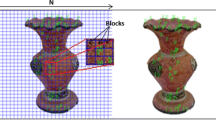Abstract
Rapid and accurate detection of collision between virtual objects is crucial for many virtual reality based applications. In order to ensure a high-level of accuracy and to meet the real-time requirement, a fast collision detection algorithm between soft bodies is proposed. The developed algorithm is a combination of stochastic methods and particle swarm optimization with adaptive Cauchy mutation. The hierarchical bounding box method is used for a rough detection in order to filter out obvious disjoint space, and the problem is converted to a nonlinear optimization problem based on the distance of points. Then particle swarm optimization with adaptive Cauchy mutation is used to find the optimal solution. When it is updated iteratively, keeping some particles experience value and variation of other particles avoids particles trapped in local optimum, which further accelerates the speed of collision detection. The algorithm is implemented and evaluated through experiments and the results confirm the advantages of the developed algorithm.








Similar content being viewed by others
References
Wu, Y., He, F., Zhang, D., Li, X.: Service-oriented feature-based data exchange for cloud-based design and manufacturing. IEEE Trans. Serv. Comput. (2015). doi:10.1109/tsc.2015.2501981
Zachmann, G.: Minimal hierarchical collision detection. In: Proceedings of the ACM Symposium on Virtual Reality Software and Technology, pp. 121-128. ACM, New York (2002)
Teschner, M., Heidelberger, B., Müller, M., Pomeranets, D., Gross, M.: Optimized spatial hashing for collision detection of deformable objects. In: Proceedings of Vision. Modeling, Visualization, pp. 47–54. Aka GmbH, Berlin (2003)
Raghupathi, L., Grisoni, L., Faure, F., Cani, M.P., Chaillou, C.: An intestine surgery simulator: real-time collision processing and visualization. IEEE Trans. Vis. Comput. Graph. 10(6), 708–718 (2004)
Wolff, S., Bucher, C.: Distance fields on unstructured grids: stable interpolation, assumed gradients, collision detection and gap function. Comput. Methods Appl. Mech. Eng. 259(100), 77–92 (2013)
Baciu, G., Wong, W.: Image-based techniques in a hybrid collision detector. IEEE Trans. Vis. Comput. Graph. 9(2), 254–271 (2003)
Mattei, T.A.: Nonhomeomorphic topological transformations and the challenge of collision detection in virtual reality simulation in neurosurgery. World Neurosurg. 81(2), 209–213 (2014)
Breuer, M., Almohammed, N.: Modeling and simulation of particle agglomeration in turbulent flows using a hard-sphere model with deterministic collision detection and enhanced structure models. Int. J. Multiph. Flow. 73, 171–206 (2015)
Kimmerle, S., Nesme, M., Faure, F.: Hierarchy accelerated stochastic collision detection. 9th International Workshop on Vision. Modeling, and Visualization, pp. 307–314. Aka GmbH, Berlin (2004)
Wang, T., Li, W., Wang, Y., Ge, Z., Han, D.: An adaptive stochastic collision detection between deformable objects using particle swarm optimization. Appl. Evol. Comput. 39(7), 450–459 (2006)
Jin, H., Zhao, H., Zhang, X., Guo, Y.: Research on collision detection algorithm between convex polyhedron based on genetic algorithm. J. Central China Norm. Univ. 40(1), 25–28 (2006)
Xia, Y., Zhao, W.: Convex polytope collision detection algorithm based on non-linear programming. J. Changchun Univ. Technol. 29(1), 82–86 (2008)
Fu, Y., Liang, J., Meng, L., Liu, Q.: Research on fast collision detection using multi-agent particle swarm optimization. J. Syst. Simul. 25(8), 1876–1880 (2013)
Kenney, J., Eberhart, R.: Particle swarm optimization. In: Proceedings of the sixth IEEE International Conference on Neural Networks, pp. 1942–1948. IEEE (1995)
Liu, L.L., Li, G.J., Wang, D.W.: Composite particle swarm optimization with nonlinear effect in dynamic environment. Control Theory & Appl. 29(10), 1253–1262 (2012)
Bonabeau, E., Dorigo, M., Theraulaz, G.: Swarm Intelligence: from Natural to Artificial Systems. Mathematics & Computer Education, Springer (2003)
Zhang, D.J., He, F.Z., Han, S.H., Li, X.X.: Quantitative optimization of interoperability during feature-based data exchange. Integr. Comput.-Aided Eng. 23(1), 31–50 (2016)
Yuan, C., He, F., Wu, Y., Zhang, D.: Meta-operation conflict resolution for human–human interaction in collaborative feature-based CAD systems. Clust. Comput. 19(1), 237–253 (2016)
Li, K., He, F., Chen, X.: Real-time object tracking via compressive feature selection. Front. Comput. Sci. 10(4), 689–701 (2016)
Sun, J., He, F., Chen, Y., Chen, X.: A multiple template approach for robust tracking of fast motion target. Appl. Math.-A J. Chin. Univ. 31(2), 177–197 (2016)
Zhou, Y., He, F., Qiu, Y.: Optimization of parallel iterated local search algorithms on graphics processing unit. J. Supercomput. 72(6), 2394–2416 (2016)
Acknowledgements
This work was supported by the National Natural Science Foundation of China under Grants 61463031, 61563035, 81660299 and 61503177, and the Science and Technology Department of Jiangxi Province of China under Grants 20121BBE50023 and 20133BCB22002.
Author information
Authors and Affiliations
Corresponding author
Rights and permissions
About this article
Cite this article
Zou, Y., Liu, P.X., Yang, C. et al. Collision detection for virtual environment using particle swarm optimization with adaptive cauchy mutation. Cluster Comput 20, 1765–1774 (2017). https://doi.org/10.1007/s10586-017-0815-6
Received:
Revised:
Accepted:
Published:
Issue Date:
DOI: https://doi.org/10.1007/s10586-017-0815-6




